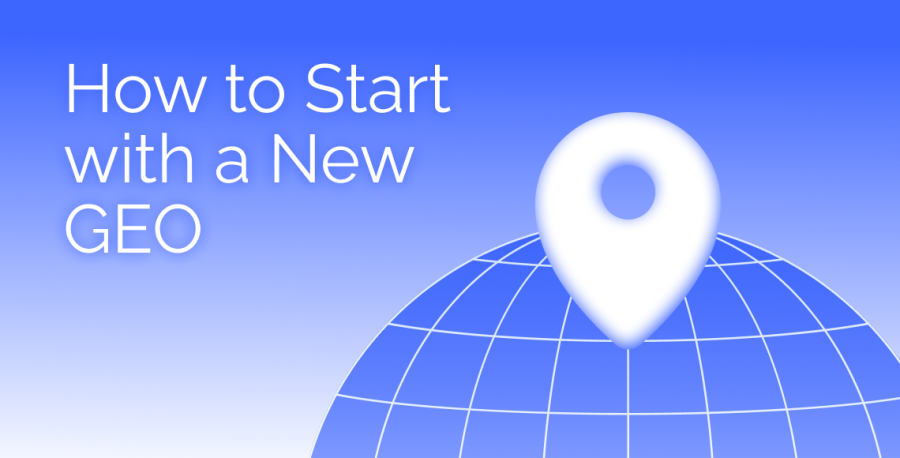Kaizen — is a Japanese term for continuous improvement. They say, you can either progress or regress, and Kaizen is a good illustration of such idea. Whether you are into trying out new verticals, ad formats, or GEOs — any novelty gets you out of your comfort zone, which is important for honing your marketing skills.
In today’s article, we will focus on entering a new GEO, explain what you should know beforehand, and provide some tips on how to do that properly. Join us, as we lay out the map of how to conquer a new GEO!
Reasons for Opting In for a New GEO
Besides getting out of your comfort zone and improving your skills as a marketer, going for a new GEO has a more pragmatical benefit — investment diversification. Nature and geopolitics can always mess with your well-established funnels, which is why it is always good to have a backup plan. You can either start conquering a new GEO when everything is fine or you will be forced to do so, when the necessity arises — the choice is yours.
Next, the world is a wonderful place, filled with events, celebrations, and inventions. These red-letter days can serve as a catalyst to your campaigning. National holidays, local sport leagues, products releases — they all attract huge volumes of traffic. Don’t forget about the negative events, like economic recession, riots, tax increase — they also have an impact on your campaign success.
Finally, entering a new GEO can be treated as a challenge to your skills. Which, when completed, gives you the bragging rights before your affiliate manager and qualifies you for better offers.
Knowledge Is Power
Prior to doing anything at all, you need to get as much data as possible. It won’t guarantee a success, but at least you will have a vision and protect yourself from common pitfalls. For the sake of convenience, all the GEOs are usually grouped into 3 categories:
- Tier-1: best payouts and highest competition. Countries in this group are craved by everyone, because the audience is relatively rich. But make sure not to forget that besides being wealthy, the audience can be very picky and ad blind at times. Northern America is a prime example of Tier-1 regions.
- Tier-2: jack-of-all-trades in the world of affiliate marketing. Countries from this group are best suited for starters, but the professionals might find them lucrative as well — good payouts with moderate competition and relatively indulgent legislation. Common examples here are SEA, CIS, and Eastern Europe in general.
- Tier-3: some say, countries here harbor trash traffic — we say, even if it’s true, the volumes do more than compensate for it. Specifically, the bids can be as low as $0.001 per click, legislation is mild, competition is low, and Ad Blockers are close to being non-existent. Many Tier-3 countries can be found in LATAM.
Whichever is your pick, it is imperative to learn about the local culture, religion, customs, habits, preferences, manners, and, depending on the vertical, slang. See, your product (and vertical as a result) caters to different needs and preferences. Sometimes, it is best to keep things professional and speak formally, e.g., Finances, eCommerce, Utilities. But at times, you need to gain favor of a more specific audience — this is where slang proficiency comes in handy, e.g., dating or gaming.
People in different countries think very differently, which is reflected in their languages. You do want to learn as many as possible of such specifics — they can make your campaigns either a blast or a bust. A very handy tool for kicking things off is Hofstede’s Insights Country Comparison. Simply enter up to 4 countries and compare them head-on, using the characteristics, like:
- Power Distance — determines whether society is socially mobile (horizontal) or not (vertical)
- Individualism — reflects the aspirations of citizens: I vs. We
- Masculinity — explains overall tolerance toward competition and goal-getting
- Uncertainty Avoidance — shows the power of traditions or adaptation
- Long-Term Orientation — depicts the nation’s readiness to suffer for greater good
- Indulgence — highlights the control of individuals over their desires
All these data will help you to design your creatives to meet the expectations of the audience. Of course, you can always visit our Creatives Library, but before that, it is good to know what you want to find. On top of Hofstede Insights, you can rely on spy tools to see which creatives are popular for a specific GEO. Consider Google Analytics and Google Trends to learn everything about the trends. Don’t forget about manual monitoring of social networks and the respective influencers.
Analyzing Target Audience & Target Market
Target audience is a subset of target market. Understanding both of them is important for generating profit. A target audience is a segment of people you expect to buy your product, while a target market is simply a group of people you want to sell your product to. Let’s start with the easier part and help you to define your target market. Answer the following questions:
- Who are my potential customers? — consider the details like age, gender, occupation, preferences, B2B vs. B2C, specifics of the industry.
- What are the buying habits of my customers? — thrifty and spendthrift people require totally different approaches.
- What is an approximate size of the market? — knowing how many potential customers you have at your disposal is significant for picking the best payout model.
- How much the consumers are ready to spend? — the specifics of an offer, e.g., iPhone, can cause even thrifty people to spend like there is no tomorrow.
- What are the main competitors in the market? — SWOT-analysis (Strength, Weakness, Opportunity, Threat) is a good place to start.
- How can I be different? — think honestly, why would people ever want to buy exactly from you and not from somebody else.
Now, let’s establish a target audience within the market:
- Delve deeper into details — demographics (age, gender), income, location, psychographics (opinion, personality, lifestyle).
- Examine external factors, affecting the audience — red-letter days, social norms, behavioral patterns. The efficiency of your media channels depend on it. Ramadan, for example, is not the best month for promoting an offer to a Muslim country, since they will be most likely to fast.
- Construct a persona — get the idea of what your ideal customer looks like, based on all the knowledge generated so far.
Prepare a Strategy
Make sure to read RollerAds for more insights for a certain GEO, e.g., SEA, LATAM, Northern America. While it is good to narrow your focus down to a single country and its culture, religion, economics etc. As a rule of a thumb, you can rely on the tier-based system to decide how to design your campaigns.
- Tier-1 — competition is stiff, so every dime counts. Make sure to run our Traffic Estimator tool to plan your expenditures in advance. In general, people here are accustomed to high standards of living, constant ad bombarding, and exceptional service. In fact, the product itself might be irrelevant — unlike the presentation of the product and subsequent emotions from social interactions. Perfect your creatives, ace your English, and try unconventional funnels, e.g., place your bet on female audience, when running an iGaming offer.
- Tier-2 — everything is less severe: legislation, ad blindness, competition. While the payouts tend to be lower, the main problem here are local languages. You do want to learn to communicate with the audience using them for your credibility to stay high. Asia, Middle East, CIS — the local cultures in these areas are unique. If Tier-1 is somewhat forgiving in this regard, here, you won’t get away without knowing the local customs. It’s for your own safety, e.g., alcohol is strictly forbidden in Turkey and many Muslim countries.
- Tier-3 — don’t be like the majority of other marketers and treat with market with due respect to win over the favor of local citizens. Make your creatives a bit more personal and people will start to like you. Tier-3 is all about the volumes, so… aim for the good enough quality. It’s better to improve the major issues with your funnels than to waste a whole day on nitpicking every tiny issue with the creatives.
Conclusion
Entering a new GEO is not difficult but can be intimidating (or exciting, depending on how you look at it). Consider this practice to be your Research & Development. Get to know a certain GEO by specializing on it and use it as your main source of capital for the investments in other regions. This way, you will always stay afloat — no matter whether new GEO does not pan out or the old one turns south.
Affiliate marketing never stagnates, so if you start doing so — you are at risk of falling behind. Exploration and investments are the key to stay ahead of competition. So decide what your new GEO of choice is, take your time to explore the local customs & habits, construct the portrait of your ideal customer, and take into account the local tier. Of course, every GEO is unique, so you will most likely need small adjustments later on down the road but for starters — this will suffice. Contact RollerAds if you need any help and have a pleasant and productive day!





